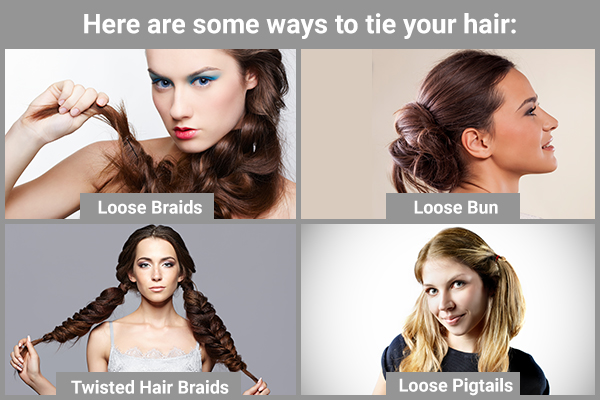In this article:
A lot of people struggle with keeping their hair untangled when sleeping at night. Finding a quick and easy way to manage hair while sleeping is important, especially for those who may have long or thick hair.

One of the best ways to keep the hair off your face and tangle-free during the night is braiding them loosely, although you have to make sure you’re braiding your hair the right way to avoid any damage to the strands.
Correct Way to Tie Hair Before Bed
Here’s how to manage and prevent unruly hair when sleeping at night.
1. Put serum on your hair before braiding
Hair care professionals claim it’s a good idea to apply hair serum before braiding or tying your hair at night because it can help to moisturize and protect your hair while you sleep, reducing the risk of breakage, tangles, and damage.
Serums are often used to add shine, smoothness, and hydration to the hair, so if you have dry or frizzy hair, applying a serum before tying it up could help to keep it moisturized and reduce flyaways.
However, if your hair is naturally oily, applying a serum may not be needed. (1)
2. To tie your hair loosely at night, be it a braid or a bun
What is important to note here is that the braid should be loose. Pulling your hair tightly to braid it can cause traction alopecia.
Traction alopecia is a preventable form of hair loss that happens as a result of wearing hairstyles that put tension on the hair regularly. Hairstyles that can induce this traction include tight braids, weaves, extensions, buns, and ponytails.
Studies show that this traction can induce an inflammatory response and follicle damage, leading to hair loss. (2)
You can try a few types of loose hair braids and buns and see which works out best for you. The braid you choose to wear should be comfortable. (2)(3)(4)
3. Some ways to tie your hair at night
These hairstyles are very effective at preventing tangles and hair breakage while you sleep.

a. Loose braids
- Comb or brush your hair to remove any tangles or knots. This will make it easier to braid your hair smoothly.
- Divide your hair into three equal sections. Hold one section in your right hand and one section in your left hand, and let the remaining section fall down the back.
- Cross the right section over the middle section so that it becomes the new middle section. Then cross the left section over the new middle section so that it becomes the new middle section.
- Continue braiding this way, alternating sides and crossing the sections over the middle until you reach the end of your hair.
- Once you reach the end of your hair, secure the braid with a soft, cloth-covered elastic hair tie. Avoid using a tight hair tie or elastic band as this can cause damage to your hair.
- If desired, you can gently loosen the braid by pulling on the strands to create a more relaxed, bohemian look.
- To protect your hair while you sleep, you can wrap the braid in a silk or satin scarf or use a silk or satin pillowcase.
b. Loose bun
- Brush your hair to remove any tangles or knots. This will make it easier to work with and help prevent breakage.
- Gather your hair at the crown of your head as if you were making a ponytail. Use your fingers or a comb to smooth out any bumps or lumps.
- Twist your hair around itself to create a rope-like strand. Keep twisting until you reach the end of your hair.
- Coil the twisted hair around itself to create a bun shape. Tuck any loose ends underneath the bun.
- Use hair ties, bobby pins, or hair clips to secure the bun in place. Make sure it’s not too tight or it may cause discomfort while you sleep.
- To prevent your hair from getting tangled while you sleep, you can cover it with a silk or satin scarf or sleep cap. This will also help protect your hair from breakage.
c. Twisted hair braids
- Brush or comb your hair to remove any tangles or knots.
- Divide your hair into two sections, either down the middle or on one side of your head.
- Take one section of hair and divide it into two smaller sections.
- Twist each section of hair in the same direction until they are tightly twisted. For example, you can twist both sections of hair clockwise.
- Once each section of hair is twisted, bring them together and twist them around each other in the opposite direction. For example, if you twisted each section of hair clockwise, twist them around each other counterclockwise.
- Continue twisting the two sections of hair together until you reach the end, and then secure the end with a hair tie.
- Repeat steps 3–6 on the other side of your head to create a second twisted hair braid.
- Optionally, you can wrap each twisted braid around itself to create a bun and secure it with a hair tie or bobby pins to prevent the braids from unraveling.
- Cover your hair with a satin scarf or bonnet to protect the braids and prevent frizz overnight.
d. Loose pigtails
- Brush your hair to remove any tangles or knots.
- Part your hair down the middle using a comb.
- Gather a section of hair from one side of the parting and twist it tightly.
- Continue twisting the section until it starts to coil around itself.
- As you twist, guide the twisted section of hair around itself to form a bun or coil.
- Use a small hair elastic to secure the coiled section in place at the base of the pigtail.
- Repeat the twisting and coiling process on the other side of the parting to create a second pigtail.
- Adjust the size and tightness of the pigtails as desired.
- Optionally, you can cover your hair with a satin scarf or bonnet to protect your pigtails and prevent frizz overnight.
Follow these steps and enjoy healthy and tangle-free hair in the morning!
Additional Tips to Prevent Hair Damage at Night

Keep these things in mind before you sleep in braids.
1. Sleep with dry hair
Braiding and sleeping with wet hair can easily lead to damaged hair because wet hair is very fragile. You also increase the odds of waking up to tangled or broken hair strands.
Moreover, sleeping with wet hair can lead to scalp issues because wet pillows and hair can harbor fungi, which may cause infections and diseases that affect scalp and hair health.
So, begin your nighttime routine early to ensure that you have enough time to dry your hair before going to sleep. (5)
2. Use a silk pillowcase
Sleeping on a silk pillow can be beneficial for your hair care routine when you sleep in braids. The silk texture is good for keeping the hair smooth throughout the night, giving you much nicer hair in the morning. (3)(6)
3. Use the right hair bands
Use hair bands that don’t cause any hair damage. Very thin plastic hair bands can be hard to get off, causing your hair to knot. So, choose the bands that have a fabric covering when you sleep. (3)
4. Use a nightcap
While you sleep, your braids can become undone. Using a nightcap can help keep your hair stay in place. A nightcap reduces friction and thus the chances of split ends. (3)
Most-Asked Questions
Is not changing the bedding bad for my hair?
Not changing your bedding frequently to have a newer and cleaner space to sleep in every night can cause your hair to become greasy and also may increase the chances of infections as dirty sheets can be breeding grounds for microbes.
I can’t braid my short hair, how do I tie my hair at night?
Short hair can be a little hard to tie into a braid. You can simply twist them loosely and gently wrap them in a silk cap or nightcap to reduce split ends and hair friction.
Is it good to leave the hair open while sleeping?

There isn’t a lot of research specifically examining whether it’s good or bad to leave your hair open while sleeping, but there are a few things to consider.
On one hand, professionals argue that leaving your hair open while sleeping can help to prevent damage and breakage that can occur when you tie your hair up or use tight hair accessories.
On the other hand, some experts say that leaving your hair open while sleeping can cause tangling, which can lead to breakage and damage. It can also create friction between your hair and your pillowcase, which can further contribute to damage and breakage.
Ultimately, whether it’s good or bad to leave your hair open while sleeping may depend on your hair type, length of hair, the condition of your hair, and personal preference.
If you wish to sleep with tied hair, following the right practices to tie your hair before bed can be helpful.
Does hair get damaged during the night?
Your hair can potentially get damaged during the night, depending on your hair type, the way you sleep, and the hair care practices you follow.
For example, sleeping with your hair tied up tightly or using hair accessories that pull on your hair can cause damage and breakage. Sleeping on a rough pillowcase or using a towel to dry your hair before bed can also cause friction and damage to your hair.
Additionally, if your hair is already damaged or prone to breakage, leaving it loose while you sleep can cause tangling, which can further contribute to damage. Taking steps to protect your hair while you sleep can help to minimize damage and promote healthy hair. (3)(6)
Final Word
Creating a loose bun or a simple single braid before you go to bed every night is a very easy method to ensure your hair remains in place and stays healthy while you sleep.
As you twist and turn in your sleep, your hair can get tangled easily, making it prone to breakage. Tying them in a braid is helpful to protect your hair from this damage.
- Was this article helpful?
- YES, THANKS!NOT REALLY


